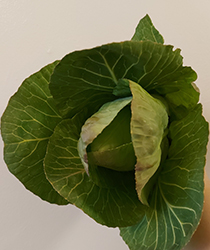Fri & Sat 8am - 8pm
Sun 8am - 7pm
Anytown, USA 12345
fax: 261.787.0463
e-mail: info@successgc.com


Plant Finder

Early Jersey Wakefield Cabbage
Brassica oleracea var. capitata 'Early Jersey Wakefield'
Height: 16 inches
Spread: 20 inches
Sunlight:
![]()
Hardiness Zone: (annual)
Description:
An early maturing variety that produces uniform heads ready for harvesting in summer; compact, conical heads are protected by tight, outer wrapper leaves; mild, sweet and tender, excellent for braising, stews, coleslaw or adding to soups
Edible Qualities
Early Jersey Wakefield Cabbage is an annual vegetable plant that is commonly grown for its edible qualities. The round green tightly-wrapped heads of foliage are usually harvested from mid summer to mid fall. The heads have a pleasant taste and a crisp texture.
The heads are most often used in the following ways:
- Fresh Eating
- Eating When Cooked/Prepared
- Cooking
Planting & Growing
Early Jersey Wakefield Cabbage will grow to be about 16 inches tall at maturity, with a spread of 20 inches. This vegetable plant is an annual, which means that it will grow for one season in your garden and then die after producing a crop.
This plant is typically grown in a designated vegetable garden. It should only be grown in full sunlight. It does best in average to evenly moist conditions, but will not tolerate standing water. This plant is a heavy feeder that requires frequent fertilizing throughout the growing season to perform at its best. It is not particular as to soil pH, but grows best in rich soils. It is somewhat tolerant of urban pollution. Consider applying a thick mulch around the root zone over the growing season to conserve soil moisture. This is a selected variety of a species not originally from North America.
